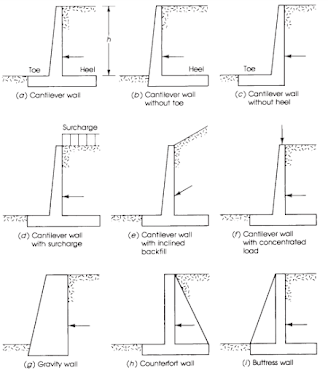TYPES OF RETAINING WALLS
1. Gravity walls usually consist of plain concrete or masonry and depend entirely on their own weight to provide stability against the thrust of the retained material. These walls are proportioned so that tensile stresses do not develop in the concrete or masonry due to the exerted forces on the wall. The practical height of a gravity wall does not exceed 10 ft.
2. Semigravity walls are gravity walls that have a wider base to improve the stability of the wall and to prevent the development of tensile stresses in the base. Light reinforcement is sometimes used in the base or stem to reduce the large section of the wall.
3. The cantilever retaining wall is a reinforced concrete wall that is generally used for heights from 8 to 20 ft. It is the most common type of retaining structure because of economy and simplicity of construction.
4. Counterfort retaining walls higher than 20 ft develop a relatively large bending moment at the base of the stem, which makes the design of such walls uneconomical. One solution in this case is to introduce transverse walls (or counterforts) that tie the stem and the base together at intervals. The counterforts act as tension ties supporting the vertical walls. Economy is achieved because the stem is designed as a continuous slab spanning horizontally between counterforts, whereas the heel is designed as a slab supported on three sides.
5. The buttressed retaining wall is similar to the counterfort wall, but in this case the transverse walls are located on the opposite, visible side of the stem and act in compression. The design of such walls becomes economical for heights greater than 20 ft. They are not popular because of the exposed buttresses.
6. Bridge abutments are retaining walls that are supported at the top by the bridge deck. The wall may be assumed fixed at the base and simply supported at the top.
7. Basement walls resist earth pressure from one side of the wall and span vertically from the basement-floor slab to the first-floor slab. The wall may be assumed fixed at the base and simply supported or partially restrained at the top.


No comments